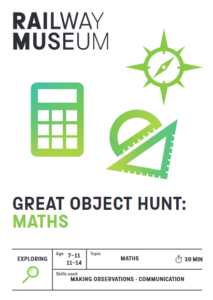As someone who went through school and much of my early adult life with a self-imposed title of “not a maths person”, I sometimes struggle to understand and fully comprehend how I ended up in the situation where I am writing an internal training course focusing on boosting confidence in maths.
I’m sure – well I know- that I’m not the only person to have presented myself with this title.
As it happened, working on a maths course was one of the best things that could have happened for me. It has destroyed my self-proclaimed title and proved to me that I am, in fact, a maths person.
In fact, it went one step further. It took me on a journey of discovering magical maths moments.
With my self-proclaimed title taken away, I started reflecting on how we at the Science Museum Group (SMG), are helping to boost confidence in maths and helping our visitors discover these magical maths moments for themselves.
Within SMG, we have the ambition, as stated in the learning strategy, to represent the complete picture of STEM (Science, Technology, Engineering and Maths) to our audiences. This meant taking steps to bring maths fully into the fold.
The subject of maths
Maths is a love or hate subject. Research shows that it’s a subject that is either someone’s favourite or least favourite subject. Maths isn’t usually a subject you see in the middle of someone’s school subject ranking list.
Amongst the main reasons people see themselves as “not a maths person” is because of the mirage maths the school subject puts up around it. Understandably all we think maths is, is the subject taught in school. It’s all we know of maths for the first 16 years of our lives so it’s perfectly understandable.
We think of maths as only being fractions, algebra, trigonometry and percentages, as something that has either a right or a wrong answer, or a right or wrong way to work out a problem. This isn’t always true.
When you break through the mirage and stereotype, something SMG does with all STEM subjects, no one can argue against the fact that maths is everywhere and the importance it plays in the world around us.
It’s often the first thing we see in the morning when we check the time after waking up. Once we’re awake we face a maths assault as we go about our day.
With the aim of making this blog easy to read and have a feel of organisation, I’ve split my thoughts and reflections along with what SMG is doing into five broad categories.
Encouraging and inspiring people to feel more connected and confident with maths
In SMG, we encourage talk and discussion around maths, particularly how it impacts our everyday life.
Teachers have a lot of curriculum boxes to tick and outcomes to achieve so there often isn’t a lot of opportunity for students to express their opinions in school classrooms.
Allowing time and space for them to do so in our museums is important for helping show how maths impacts the world around us, and goes a long way to chipping away the mirage of maths just being a school subject.
Along with this, talking about subjects helps show people that maths is something they can do, builds confidence and ownership, and it can be part of their lives.
We’ve created a suite of maths trails for all our museums.
The Great object hunt: Shapes and patterns encourages people to explore with a maths point of view. All these trails are great tools for building confidence and ownership in our visitors.
Create experiences which enable everyone to get involved
A lot of people develop a fear and anxiety around maths. A portion of these come from previous negative experiences. This means when they are faced with the subject again, they recall that negative feeling and emotion.
Past experiences and anxiety around the subject can lead to something called maths anxiety which can be debilitating. It’s a common feeling in adults and children all around the world.
By providing positive experiences, we hope that when people next face this subject, they now have a more positive and inspiring experience to remember.
If you would like a more detailed look at maths engagement in our museums take a look at this blog post.
Highlight WHO USES maths
Just like science and engineering, many people have a stereotype that comes to mind when thinking of a mathematician. It is often presumed that only incredibly intelligent people can do maths, which isn’t true at all (although, of course, some mathematicians are incredibly intelligent!).
We aim to show our visitors the diversity of people who use maths and computing, especially those from non-stereotypical fields.
At the National Railway Museum we did a workshop called “Engineer like me” which was a gameshow format where the audience asked engineers questions about not only their jobs but their everyday lives.
This not only showed that everyone could be an engineer, but also that engineers weren’t people on a pedestal, they’re people just like us. It took the jobs off the “only certain people can do this job” pedestal and showed they were accessible for all.
These are the conversations we are having about mathematicians in SMG.
skills
We all use a wide range of skills every day, but we don’t always realise we’re using them until someone points it out to us. The maths skills we use are no different.
Whether it’s checking we have the right change from a shop purchase, working out how long it will take us to walk to work or what time train or bus we need to catch to get somewhere on time, our lives are crammed full of maths skills.
By acknowledging that our visitors are doing maths skills it helps them see that they can do maths and use maths skills all the time.
At the National Railway Museum, a frequent school holiday programme includes a maths activity “Pixel puzzles”. This is a simple paint by numbers colouring sheet where participants have to solve simple addition, subtraction, multiplication or divisionproblems to work out the correct colour each square needs to be.

Separate key stage 1 and 2 problems have been produced meaning all ages can join in.
This is a wonderful activity because it not only introduces and helps participants develop basic maths skills, but also shows that maths is something they can do- because they have a successfully coloured in picture to prove it.
By highlighting skills, we can help show that everyone can do maths, and everyone is a maths person.
celebrate and showcase the magic of maths
Maths is truly magical, it might not always seem it and it won’t necessarily be your favourite subject, but the magic of maths is easy to see once you look past the “maths is a school subject” filter. We want to show that maths can be fun and something visitors don’t expect. Like my personal journey to discovering magical maths moments, hopefully we find more SMG museum visitors going on the same journey.
Related blogs
- Making maths connections on national numeracy day
- Maths engagement: Helping people connect with maths
- Maths engagement: Maths in our museums
Our ‘maths engagement’ series shares insights from the research, development, and delivery stages of our new maths engagement offer.